0959ss14
0959ss14.doc
Facility Ground-Water Monioring Requirements (Renewal)
OMB: 2050-0033
SUPPORTING STATEMENT FOR
EPA INFORMATION COLLECTION REQUEST NUMBER 0959.14
"FACILITY GROUND-WATER MONITORING REQUIREMENTS”
January 2012
TABLE OF CONTENTS
1. IDENTIFICATION OF THE INFORMATION COLLECTION
1(a) TITLE AND NUMBER OF THE INFORMATION COLLECTION 1
1(b) SHORT CHARACTERIZATION 1
2. NEED FOR AND USE OF THE COLLECTION
2(a) NEED AND AUTHORITY FOR THE COLLECTION 4
2(b) USE AND USERS OF THE DATA 6
3. NONDUPLICATION, CONSULTATIONS, AND OTHER COLLECTION CRITERIA
3(a) NONDUPLICATION 8
3(b) PUBLIC NOTICE 8
3(c) CONSULTATIONS 9
3(d) EFFECTS OF LESS FREQUENT COLLECTION 9
3(e) GENERAL GUIDELINES 9
3(f) CONFIDENTIALITY 9
3(g) SENSITIVE QUESTIONS 9
4. THE RESPONDENTS AND THE INFORMATION REQUESTED
4(a) RESPONDENTS 10
4(b) INFORMATION REQUESTED 10
5. THE INFORMATION COLLECTED -- AGENCY ACTIVITIES, COLLECTION METHODOLOGY, AND INFORMATION MANAGEMENT
5(a) AGENCY ACTIVITIES 19
5(b) COLLECTION METHODOLOGY AND MANAGEMENT 20
5(c) SMALL ENTITY FLEXIBILITY 20
5(d) COLLECTION SCHEDULE 21
6. ESTIMATING THE BURDEN AND COST OF COLLECTION
6(a) ESTIMATING RESPONDENT BURDEN 22
6(b) ESTIMATING RESPONDENT COSTS 22
6(c) ESTIMATING AGENCY BURDEN AND COSTS 23
6(d) ESTIMATING THE RESPONDENT UNIVERSE AND TOTAL BURDEN AND COSTS 24
6(e) BOTTOM LINE BURDEN HOURS AND COST 28
6(f) REASONS FOR CHANGE IN BURDEN 28
6(g) BURDEN STATEMENT 28
1. IDENTIFICATION OF THE INFORMATION COLLECTION
1(a) Title and Number of the Information Collection
This Information Collection Request (ICR) is entitled, "Facility Ground-Water Monitoring Requirements (Renewal)," ICR number 959.14.
1(b) Short Characterization
Subtitle C of the Resource Conservation and Recovery Act of 1976 (RCRA) creates a comprehensive program for the safe management of hazardous waste. Section 3004 of RCRA requires owners and operators of facilities that treat, store, or dispose of hazardous waste to comply with standards established by EPA that are "necessary to protect human health and the environment." Section 3005 provides for implementation of these standards under permits issued to owners and operators by EPA or authorized States. Section 3005 also allows owners and operators of facilities in existence when the regulations came into effect to comply with applicable notice requirements to operate until a permit is issued or denied. This statutory authorization to operate prior to permit determination is commonly known as "interim status." Owners and operators of interim status facilities also must comply with standards set under Section 3004.
EPA promulgated ground-water monitoring standards for interim status facilities in 1980 (45 FR 33154; May 19, 1980), codified in 40 CFR Part 265, Subpart F, and for permitted facilities in 1982 (47 FR 32274; July 26, 1982), codified in 40 CFR Part 264, Subpart F. Both sets of standards establish programs for protecting ground water from releases of hazardous wastes from land disposal facilities (LDFs). Under Part 264, LDFs also are known as regulated units and include surface impoundments, waste piles, land treatment units, and landfills.
This ICR examines the ground-water monitoring standards for permitted and interim status facilities at 40 CFR Parts 264 and 265, as specified. Sections 1 through 5 of this ICR describe the ground-water monitoring information collection requirements. In Section 6, EPA estimates the annual hour and cost burden to respondents and the Agency in carrying out these requirements.
There were no terms of clearance from the Office of Management and Budget (OMB) that were applied to the previous GWM ICR, 959.12. In the supporting statement for 959.12, EPA discussed OMB terms of clearance from the earlier GWM ICR, including examining record keeping and reporting requirements and burden reduction considerations. At that time, EPA determined that it was not appropriate to make changes in GWM reporting requirements. No changes have been made to the GWM requirements since 2001.
The following paragraphs describe the information collection requirements addressed in this ICR.
PERMITTED FACILITIES
40 CFR Part 264, Subpart F establishes requirements for permitted LDFs, but not all information requirements in Part 264 are covered in this ICR. The information collection requirements in the following sections are found in either "General Hazardous Waste Facility Standards," ICR number 1571, or "Part B Permit Application, Permit Modifications, and Special Permits," ICR number 1573.
Applicability, Compliance Period, and General Ground-Water Monitoring Requirements
Information collection requirements under sections 264.90, 264.96, and 264.97 are covered in either ICR Nos. 1571 or 1573 because they are either retained in the operating record or submitted with a permit application. Section 264.90(b) discusses demonstrations for exemption from regulation of releases into the uppermost aquifer. These requirements are covered in ICR number 1573. Section 264.96(c) discusses demonstrations that the ground-water protection standard of section 264.92 has not been exceeded for three years. Section 264.97(g)(1)-(2) covers proposals for intervals between sampling and sampling procedures. These requirements are covered in ICR number 1571. Section 264.97(h) discusses statistical methods used for evaluating ground-water data. Section 264.97(j) discusses the recordkeeping of ground-water data. These requirements are covered in ICR number 1573. Requirements under these sections are not discussed elsewhere in this ICR.
Detection Monitoring Program
Under section 264.98, owners and operators of LDFs are required to implement a detection monitoring program to determine whether hazardous wastes are leaking from the facility at levels great enough to warrant compliance monitoring under section 264.99. The detection monitoring requirements under 40 CFR 264.98 require owners and operators to keep a record of all ground-water analytical data collected during monitoring, and to submit notifications of detected contamination, the presence of new constituents, and exceeded concentration limits. Records under these sections must be made available to EPA for review. The following detection monitoring sections are not included in this ICR. Section 264.98(g)(4) addresses application for a permit modification to establish a compliance monitoring program. Section 264.98(h) addresses application for a permit modification to make changes to the detection monitoring program. These requirements are covered in ICR number 1573.
Compliance Monitoring Program
Under section 264.99, owners and operators may have to implement a compliance monitoring program to determine if a statistically significant increase over the concentration limits of the hazardous constituents listed in the permit exists. The compliance monitoring requirements under 40 CFR 264.99 require owners and operators to keep a record of all ground-water analytical data collected during monitoring, and to submit notifications of detected contamination, the presence of new constituents, and exceeded concentration limits. Records under these sections must be made available to EPA for review. Owners and operators of facilities detecting contamination must also submit an engineering feasibility plan for corrective action or, if they wish to seek approval of an alternate concentration limit (ACL), all data necessary to establish an ACL. The following compliance monitoring sections are not included in this ICR. Section 264.99(h)(2) discusses application for a permit modification to establish a corrective action program. Sections 264.99(i)(3) and 264.99(j) discuss applications for permit modifications to make changes to the compliance monitoring program because of contamination from a non-regulated unit, and changes to the compliance monitoring program, respectively. These requirements are covered in ICR number 1573.
Corrective Action
Under section 264.100, corrective action may be instituted to bring a facility back into compliance with the ground-water protection standard. The corrective action requirements under 40 CFR 264.100 require owners and operators to make demonstrations in order to terminate, or obtain exemptions from, corrective action. Owners and operators conducting a corrective action program must keep a record of all ground-water analytical data collected during monitoring, submit reports on the effectiveness of the program, and submit permit modification applications where appropriate. The following corrective action program sections are not included in this ICR. Section 264.100(h) addresses application for permit modifications to make changes to the corrective action program. These requirements are covered in ICR number 1573. Section 264.101(c) discusses demonstrations for exemption from undertaking corrective action beyond the facility boundary. These requirements are all covered in ICR number 1571.
INTERIM STATUS FACILITIES
40 CFR Part 265, Subpart F establishes requirements for interim status land disposal facilities. All of the information collection requirements for interim status LDFs are covered by this ICR.
Applicability and Alternative Ground-Water Monitoring Systems
Under section 265.90, all or part of the interim status ground-water monitoring requirements may be waived if the owner or operator provides (1) a written demonstration establishing that corrosive wastes from the facility will be neutralized to the extent that they no longer meet corrosivity characteristics before they can migrate out of the impoundment, and/or (2) a written demonstration, kept at the facility, which establishes that there is a low potential for migration of hazardous waste or hazardous waste constituents from the facility through the uppermost aquifer to water supply wells or to surface water. The first demonstration applies only to surface impoundments that are used to neutralize wastes which are hazardous solely because they exhibit corrosivity characteristics, and contain no other hazardous wastes.
40 CFR 265.90 also allows some owners and operators to implement an alternative ground-water monitoring system. Owners and operators installing an alternative system must submit a specific plan that meets the regulatory standards of section 265.93(d)(3). Owners and operators of these facilities must also conduct a ground-water quality assessment program, report the initial results of the assessment program to the Regional Administrator, and keep records of subsequent quarterly assessments until final closure of the facility. An annual ground-water quality assessment report is also required.
40 CFR 265.91 also allows some owners and operators to select an alternate hydraulically down gradient monitoring well location, provided they meet certain criteria, make and submit a demonstration and obtain a certification from a qualified ground-water scientist.
Sampling, Analysis and Assessment
40 CFR 265.92 and 265.93 require owners and operators of non-exempt interim status facilities to develop and conduct a sampling and analysis program to monitor for ground-water contamination, and to implement a ground-water quality assessment program if contamination is detected. Ground-water quality assessment plans must be submitted to EPA. The sampling and analysis plan must be kept at the facility, and made available for inspection so that EPA may refer to it in evaluating the effectiveness of the program. Owners and operators must also provide notification of changes in indicator parameter concentrations and provide an initial ground-water quality assessment report. Notifications and reports are collected and analyzed by EPA in order to provide immediate information on contamination and changes in ground-water quality.
Recordkeeping and Recording
Specific recordkeeping and reporting requirements for interim status LDFs are established under 40 CFR 265.94. These regulations require that facilities not conducting ground-water quality assessments keep records of all ground-water analytical data at the facility. These facilities also are required to submit quarterly reports during the first year on drinking water suitability parameters, and annual reports on indicator parameter concentrations, variations from background levels, and ground-water surface elevations. Facilities conducting ground-water quality assessments must keep records of the data obtained during the assessments, and submit annual ground-water quality assessment reports. Reports collected under this section provide EPA with the information necessary to evaluate the impact of the facility on ground-water quality. Records are not submitted to EPA but must be made available for inspection.
2. NEED FOR AND USE OF THE COLLECTION
2(a) NEED AND AUTHORITY FOR THE COLLECTION
PERMITTED FACILITIES
Detection Monitoring
40 CFR 264.98(c) requires owners and operators of facilities conducting a detection monitoring program to keep a record of all ground-water analytical data obtained under the program. Owners and operators must notify EPA of any statistically significant evidence of ground-water contamination ( §264.98(g)(1)), but may demonstrate that such contamination is caused by a source other than the regulated facility. Owners and operators detecting contamination are required to submit an engineering feasibility plan for a corrective action program and, if they wish to seek approval for an ACL, all data necessary to establish an ACL (§264.98(g)(5)). Owners, operators and EPA use the information required under this section to determine whether the facility is affecting ground-water quality, and whether a compliance monitoring program under section 264.99 is warranted. This information is also used for developing and evaluating an appropriate compliance monitoring program. The detection monitoring requirements contribute to EPA's goal of preventing undetected releases of hazardous waste from treatment, storage, and disposal facilities.
Compliance Monitoring
40 CFR 264.99(c)(2) requires owners and operators of facilities conducting a compliance monitoring program to keep a record of all ground-water analytical data obtained during monitoring. Owners and operators are required under sections 264.99(g) and (h) to notify EPA of the presence of new constituents or exceeded concentration limits at any monitoring well. Section 264.99(i) allows owners and operators to demonstrate that the exceeded concentration limits are caused by a source other than the regulated facility, or by an error in sampling and analysis. The information in this section is used by owners, operators and EPA to evaluate the extent of ground-water contamination at the facility and to determine whether a corrective action program under section 264.100 is warranted. The compliance monitoring requirements contribute to EPA's goal of ensuring that ground-water contamination that exceeds acceptable levels is quickly identified and addressed.
Corrective Action
EPA promulgated regulations in 40 CFR 264.100 establishing requirements for owners and operators of hazardous waste LDFs conducting a corrective action program. Section 264.100(g) requires owners and operators conducting a corrective action program to submit a semi-annual report on the effectiveness of the program. This report allows EPA to monitor the progress of corrective action and identify any changes that should be made to the program. Exemption from the corrective action requirements may be obtained by submitting a demonstration under section 264.100(e)(2). Corrective action may be terminated by demonstrating that the ground-water protection standard has not been exceeded for a period of three consecutive years under section 264.100(f). This information is used by EPA to confirm that corrective action is undertaken where necessary to address ground-water contamination. The corrective action requirements contribute to EPA's goal of minimizing damage to the environment caused by the treatment, storage and disposal of hazardous waste by bringing regulated facilities back into compliance with their ground-water protection standards.
INTERIM STATUS FACILITIES
Applicability and Alternative Ground-Water Monitoring Systems
EPA promulgated standards in 40 CFR 265.90 establishing the applicability of ground-water monitoring and requirements for alternative ground-water monitoring systems. To waive the ground-water monitoring requirements, owners and operators must submit the demonstrations required under 40 CFR 265.90(c) and/or 265.90(e). The demonstrations under this section are meant to ensure that LDFs are not unnecessarily required to conduct ground-water monitoring. Non-exempt facilities planning to implement an alternative ground-water monitoring system must submit a monitoring plan (§265.90(d)(1)), as well as initial and periodic reports on ground-water quality as required under sections 265.90(d)(3) and (5), and must maintain a record of all ground-water quality assessments at the facility. Facilities planning to implement an alternate monitoring well location must meet certain criteria, make and submit a demonstration and obtain a certification from a qualified ground-water scientist. The requirements for alternative ground-water monitoring systems ensure that the alternative systems used are capable of early contamination detection, and the reports submitted to EPA are used to assess the impact of the facility on ground-water quality. This information contributes to EPA's goal of quickly detecting and characterizing contamination from LDFs in order to minimize damage to human health and the environment.
Sampling, Analysis and Assessment
EPA promulgated regulations in 40 CFR 265.92 requiring owners and operators to develop and implement sampling and analysis procedures for identifying ground-water contamination. The sampling and analysis plan must be kept on file at the facility and may be reviewed by EPA to determine whether the procedures effectively detect ground-water contamination (§265.92(a)). Section 265.93(d)(1) requires owners and operators to notify EPA in writing of significant increases (or pH decreases) in indicator parameter concentrations at down gradient wells. Owners and operators of facilities where contamination is detected must develop and implement a ground-water quality assessment program, and submit an initial assessment report (§265.93(d)). These requirements provide EPA with the information necessary to evaluate the impact of the facility on ground-water quality. The sampling, analysis and assessment requirements contribute to EPA's goal of quickly detecting and characterizing contamination from LDFs in order to minimize damage to human health and the environment.
Recordkeeping and Reporting
EPA promulgated regulations in 40 CFR 265.94(a) establishing recordkeeping and reporting requirements for interim status facilities not conducting a ground-water quality assessment program. The regulations direct owners and operators of these facilities to keep records of initial background data, annual and semi-annual ground-water quality and indicator parameter analyses, and ground-water surface elevation data. A record of subsequent indicator parameter comparisons with background levels is also required. Reports included under this section include a quarterly report on drinking water suitability parameters during the first year, and annual reports on indicator parameters and variances from background concentrations, and an annual report on ground-water surface elevations.
40 CFR 265.94(b) establishes recordkeeping and reporting requirements for facilities conducting ground-water quality assessment programs. Owners and operators of these facilities are required to keep records of analyses and evaluations conducted under the program, and to submit annual assessment reports to the Regional Administrator.
The records required under this section provide owners and operators with the information necessary to evaluate changes in ground-water quality at their facilities over time. The reporting requirements supply EPA with the information necessary to determine the impact of the facility on ground-water quality. These recordkeeping and reporting requirements contribute to EPA's goal of preventing undetected releases of hazardous waste from treatment, storage and disposal facilities.
2(b) USE AND USERS OF THE DATA
PERMITTED FACILITIES
Detection Monitoring
Records of ground-water analytical data are used primarily by owners and operators in determining whether their facilities are contaminating ground-water. Notifications of detected contamination are used by EPA to identify facilities that warrant closer attention, and as a basis for evaluating plans for compliance monitoring programs at these facilities. EPA uses data justifying ACLs to determine whether the new limits requested by owners and operators at a contaminated facility are appropriate, and uses engineering feasibility plans for corrective action to determine whether the proposed corrective action program will be effective at the contaminated facility. Demonstrations submitted under this section are used by owners and operators to obtain exemptions from the burden of conducting further monitoring or corrective action activities for contamination which is unrelated to activities at the facility.
Compliance Monitoring
Records of ground-water analytical data required under the compliance monitoring program are used primarily by owners and operators in determining the extent of ground-water contamination and in identifying exceeded concentration limits or new constituents. Notifications of new constituents are used by EPA in updating the facility monitoring requirements so that all constituents are carefully monitored. EPA uses notifications of exceeded concentration limits to learn as much as possible about the ground-water impact of each contaminated facility, and as a basis for evaluating plans for corrective action. Demonstrations submitted under this section are used by owners and operators to obtain exemptions from the burden of conducting corrective action for contamination which is unrelated to activities at the facility.
Corrective Action
Owners and operators of some contaminated facilities use the exemption demonstration submitted under this section to establish lack of need to implement a corrective action program. The demonstration required to terminate corrective action is used by EPA to evaluate the need for continued efforts where corrective action has already been instituted, and by owners and operators to justify such termination. Reports on the effectiveness of corrective action are used by both EPA and owners and operators to evaluate the success of corrective action and identify any improvements which can be made to the program.
INTERIM STATUS FACILITIES
Applicability and Alternative Ground-Water Monitoring Systems
The exemption demonstrations provided under this section are used by owners and operators of interim status facilities to minimize their monitoring burden, provided that their facilities pose little or no threat to ground-water quality. Plans for an alternative ground-water monitoring system are used by owners and operators of some facilities as a guideline for conducting ground-water quality analyses. The alternative ground-water monitoring plan is reviewed by EPA to determine whether it is appropriate for the specific facility, and the terms of the plan are enforceable against the owner or operator. Ground-water quality assessment reports and records of analyses conducted at facilities using alternative systems are used by owners, operators and EPA to determine the impact of these facilities on ground-water quality, and to identify any changes which should be made to the alternative ground-water monitoring program. Alternate down gradient well locations give some facilities flexibility in placing ground-water monitoring wells. The demonstrations allow EPA to assure that these alternate well locations will not adversely threaten ground-water quality.
Sampling, Analysis and Assessment
The ground-water sampling and analysis plan required under this section is used primarily by owners and operators as a guideline for determining whether their facilities are leaking. Although the sampling and analysis plan is not formally submitted to EPA, it may be reviewed by EPA at any time to determine whether it is appropriate for identifying and evaluating ground-water contamination at the facility. The terms of the plan are enforceable against the owner or operator. Notifications of increased indicator parameter concentrations are used by EPA to identify facilities requiring ground-water quality assessment plans. The plan is used primarily as a guideline for owners and operators in determining the extent of ground-water contamination. Reports on ground-water quality are used both by owners and operators and by EPA to evaluate the degree of ground-water contamination and the extent of contaminant migration.
Recordkeeping and Reporting
The recordkeeping requirements under section 265.90(a) require owners and operators of facilities not conducting ground-water quality assessment programs to keep records of initial background data; subsequent analyses of ground-water quality and indicator parameters; ground-water surface elevations; indicator parameter comparisons with background levels; and ground-water quality assessment data. These records are used primarily by owners and operators, but may also be reviewed by EPA upon request. Background data are used as a baseline for evaluations of ground-water quality. Subsequent analyses and comparisons with background levels are used by owners and operators to identify leaking contaminants. Records of ground-water surface elevations assist owners and operators in determining whether monitoring samples are being drawn from appropriately located wells. Records required in this section also provide an ongoing history of ground-water quality at the facility, which is important because changes in ground-water quality may occur slowly over time.
Reports on drinking water suitability parameters submitted during the first year are used by EPA to identify facilities which may already be contaminating ground water and to establish priorities for issuing permits. Reports on indicator parameters are used by EPA to evaluate the impact of the facility on ground-water quality and to identify facilities where further investigation or action is warranted. Reports on ground-water surface elevations are used by EPA to confirm that monitoring wells are appropriately placed.
The recordkeeping requirements of section 265.90(b) require owners and operators of facilities conducting ground-water quality assessments to record and report on information collected during the assessments. The records and reports are used by owners and operators and EPA, respectively, to evaluate the impact of facilities on ground-water quality.
3. NONDUPLICATION, CONSULTATIONS, AND OTHER COLLECTION CRITERIA
3(a) NONDUPLICATION
RCRA is currently the sole Federal statutory vehicle for protecting ground-water quality from the effects of the hazardous waste TSDFs for which this monitoring is being required. Pursuant to the Clean Water Act, standards have been established for maintaining surface water quality; however, that Act has limited jurisdiction over ground-water, and the implementation of the Act has only sought to protect against ground-water contamination by activities such as sewage treatment and related sludge disposal. The requirements of RCRA thus provide the only means for gathering information to use in determining the ground-water quality impacts of the regulated facilities. Most of the information required by RCRA is not available from any source but the respondents.
3(b) PUBLIC NOTICE
In compliance with the Paperwork Reduction Act of 1995, EPA issued a public notice in the August 9, 2011, Federal Register (76 FR 48859), soliciting public comments for a 60‑day period ending October 11, 2011. No comments were received.
3(c) CONSULTATIONS
The burden hours and cost estimates for this ICR have been well established, and no additional consultations have been made. EPA has consulted previously with Richard M. Strang of the Environmental Affairs Office of the Eastman Chemical Company, who indicated that the Agency’s burden estimates for permitted facilities were consistent with their experience and there have not been significant changes in GWM costs for permitted facilities over the succeeding years.
3(d) EFFECTS OF LESS FREQUENT COLLECTION
Collecting these data less frequently would hinder the Agency in promptly identifying facilities that may be discharging hazardous wastes or constituents to ground-water. Thus, Agency action to require remediation for the protection of potential ground-water users would be hampered or delayed. If contamination problems are allowed to proliferate and persist unremediated, the potential cost of future remediation may grow substantially. Additionally, for facilities which are known to be discharging hazardous wastes to ground-water, a reduction in the information collection requirements would seriously impair the Agency's ability to assess the rate of movement and extent of contamination from discharging facilities.
3(e) GENERAL GUIDELINES
Requirements and justification for reporting information to the Agency more often than quarterly are discussed under Section 4(d). Collection activities that must be prepared in less than 30 days are also discussed in Section 4(d). Sections 265.94(a)(1) and 265.94(b)(1) require the maintenance of records throughout the active life of the facility and, for disposal facilities, throughout the post-closure care period as well. These records provide a baseline for determining the presence and concentration of hazardous releases to ground-water, and provide a means to assess the effects of the facility on ground-water throughout its active life. Without these records, the impact of the facility on the ground-water beneath and adjacent to it cannot be ascertained.
3(f) CONFIDENTIALITY
Section 3007(b) of RCRA and 40 CFR Part 2, Subpart B, which define EPA's general policy on the public disclosure of information, contain provisions for confidentiality.
3(g) SENSITIVE QUESTIONS
No questions of a sensitive nature are included in any of the information collection requirements.
4. THE RESPONDENTS AND THE INFORMATION COLLECTED
4(a) Respondents and SIC Codes
Following are the Standard Industrial Classification (SIC) codes and the North American Industry Classification System (NAICS) codes of facilities most likely subject to the requirements in this ICR.
Description |
SIC Codes |
NAICS Codes |
Industrial Inorganic Chemicals |
281 |
32518, 32513 |
Plastic materials, Synthetic Resins, etc. |
282 |
3252 |
Drugs |
283 |
3254 |
Soaps, Detergents, etc. |
284 |
3256 |
Paints, Varnishes, etc. |
285 |
32551 |
Industrial Organic Chemicals |
286 |
32511, 32512, 32519 |
Miscellaneous Chemical Products |
289 |
3255 |
Petroleum |
291 |
324199 |
Metal Working |
330 |
331 |
Sanitary Services |
495 |
5622, 5629 |
4(b) Information Collected
PERMITTED FACILITIES
Reading the Regulations
(i) Data items:
There are no data items associated with reading the regulations. However, respondents must first read the regulations in order to comply with ground-water monitoring requirements.
(ii) Respondent activities:
In order to comply with the ground-water monitoring requirements, respondents must perform the following activities:
• Read the regulations.
Ground-water Monitoring System
(i) Data items:
There are no data items associated with implementing a ground-water monitoring system. However, respondents must implement a ground-water monitoring system in order to comply with ground-water monitoring requirements.
(ii) Respondent activities:
In order to implement a ground-water monitoring system, respondents must perform the following activities:
• Conduct a hydrogeologic investigation; and
• Design and install a ground-water monitoring system.
Detection Monitoring
(i) Data items:
Owners and operators required to perform detection monitoring must provide the following data:
• A record of ground-water analytical data as measured and in a form necessary for the determination of statistical significance, as required by §264.98(c);
• Notification to the Regional Administrator within seven days of statistically significant evidence of contamination, including information on chemical parameters or hazardous constituents, as required by §264.98(g)(1);
• All data necessary to justify an alternate concentration limit if sought under §264.94(b), submitted within 180 days of confirmation of a release of hazardous constituents to ground-water, as required by §264.98(g)(5)(i);
• An engineering feasibility plan for a corrective action program, submitted within 180 days of confirmation of a release of hazardous constituents to ground-water, as required by §264.98(g)(5)(ii);
• To demonstrate that contamination, if detected, is caused by a source other than a regulated unit or by an error in sampling, analysis, statistical evaluation or natural variation in the ground-water, as required by §264.98(g)(6);
- A notification to the Regional Administrator, submitted within seven days of detection, of intent to make such a demonstration.
- A report to EPA, submitted within 90 days of the notification, demonstrating that the exceeded standards were caused by a source other than a regulated unit or by an error in sampling, analysis, or evaluation.
(ii) Respondent activities:
In order to provide the data items listed above, respondents must perform the following activities:
• Determine the ground-water flow rate and direction (annually);
• Sample and analyze ground-water (semi-annually);
• Record ground-water analytical data at the facility (semi-annually);
• Prepare and submit the notification of contamination;
• Re-sample and analyze ground-water for Appendix IX constituents;
• Compile and submit data necessary to establish an alternate concentration limit;
• Prepare and submit an engineering feasibility plan for corrective action;
• Prepare and submit notification of intent to make a demonstration of error or contamination from another source; and
• Prepare and submit the demonstration.
Compliance Monitoring
(i) Data items:
Owners and operators required to perform compliance monitoring must provide the following data:
• A record of all ground-water analytical data obtained under the compliance monitoring program as measured and in a form necessary for the determination of statistical significance by §264.99(c)(2);
• Notification, submitted to the Regional Administrator within seven days of initial or confirmed analysis, of the presence of new constituents in ground-water not already identified in the facility permit, and their concentrations, as required by §264.99(g);
• Notification, submitted to the Regional Administrator within seven days of detection, that concentration limits under §264.94 are being exceeded at any monitoring well, as required by §264.99(h)(1);
• To demonstrate that contamination, if detected, is caused by a source other than a regulated unit or by an error in sampling, analysis, statistical evaluation or natural variation in the ground-water, as required by §264.99(i):
- A notification to the Regional Administrator, submitted within seven days of detection, of intent to make such a demonstration.
- A report, submitted within 90 days of the notification, demonstrating that the exceeded standards were caused by a source other than a regulated unit or by an error in sampling, analysis, or evaluation.
(ii) Respondent activities:
In order to provide the data items listed above, respondents must perform the following activities:
• Determine the ground-water flow rate and direction (annually);
• Sample and analyze ground-water (semi-annually);
• Record ground-water analytical data at the facility (semi-annually).
• Compile information for notification of new constituents;
• Prepare and submit the notification of new constituents;
• Compile information on exceeded concentration limits;
• Prepare and submit the notification of exceeded concentration limits;
• Prepare and submit a notification of intent to make a demonstration of error or contamination from another source; and
• Prepare and submit the demonstration.
Corrective Action
(i) Data items:
Owners and operators required to perform corrective action must provide the following data:
• To obtain an exemption from the requirements to take corrective action beyond the facility's boundary, a demonstration that the owner or operator was unable to obtain the necessary permission to undertake such corrective action, despite his or her best efforts, as required by §264.100(e)(2);
• To terminate corrective action, a demonstration, as required by §264.100(f) that the ground-water protection standard has not been exceeded for a period of three consecutive years;
• A semi-annual report on the effectiveness of the corrective action program, as required by §264.100(g); and
(ii) Respondent activities:
In order to provide the data items listed above, respondents must perform the following activities:
• Design and install additional ground-water monitoring wells;
• Sample and analyze ground-water (semi-annually);
• Record ground-water analytical data at the facility (semi-annually);
• Compile and submit information for the demonstration for exemption from corrective action;
• Compile and submit information for the demonstration for termination of corrective action;
• Develop and submit to EPA a semi-annual report on the effectiveness of the program.
INTERIM STATUS FACILITIES
Reading the Regulations
(i) Data items:
There are no data items associated with regulations. However, respondents must first read the regulations in order to comply with ground-water monitoring requirements.
(ii) Respondent activities:
In order to comply with the ground-water monitoring requirements, respondents must perform the following activities:
• Read the regulations.
Applicability and Alternative Ground-Water Monitoring Systems
(i) Data items:
Section 265.90 establishes the applicability of the ground-water monitoring requirements at interim status facilities, and discusses requirements for alternative ground-water monitoring systems. Data items required under these regulations include:
• A demonstration, necessary in order to waive all or part of the ground-water monitoring requirements, of low potential for migration of hazardous waste or hazardous waste constituents from the facility through the uppermost aquifer to water supply wells or surface water (§265.90 (c)). This demonstration must be kept in writing at the facility and must be certified by a qualified geologist or geotechnical engineer. The demonstration must establish the following:
- The potential for migration of hazardous waste or hazardous waste constituents from the facility to the uppermost aquifer by an evaluation of water balance and unsaturated zone characteristics; and
- The potential for hazardous waste or hazardous waste constituents which enter the uppermost aquifer to migrate to a water supply well or surface water by an evaluation of saturated zone characteristics and the proximity of the facility to water supply wells or surface water;
• A demonstration, necessary in order to waive the ground-water monitoring requirements for certain surface impoundments, that establishes, based upon consideration of the characteristics of the wastes and the impoundment, that the corrosive wastes will be neutralized to the extent that they no longer meet the corrosivity characteristic before they can migrate out of the impoundment. This demonstration must be in writing and must be certified by a qualified professional (§265.90(e));
• If necessary, a specific plan for an alternative ground-water monitoring system, certified by a qualified geologist or geotechnical engineer and submitted to the Regional Administrator within one year after the effective date of the regulations or within one year of obtaining interim status (§265.90(d)(1));
• If an alternative ground-water monitoring system is used, a written report containing an assessment of ground-water quality submitted to the Regional Administrator within 15 days of the initial assessment, followed by annual reports submitted by March 1 following each calendar year (§265.90(d)(3) and (5)); and
• For alternative systems, a record of the analyses conducted to determine ground-water quality under §265.90(d)(3) to be kept throughout the active life of the facility, and, for disposal facilities throughout the post-closure period as well (§265.90(d)(5)).
• For alternate hydraulically down gradient monitoring well locations, a demonstration showing that the location will meet the criteria outlined in §265.91(a)(3) and a certification by a qualified ground-water scientist that
(ii) Respondent Activities:
In order to provide the data items listed above, respondents must perform the following activities:
• Develop and submit the demonstrations;
• Maintain records of the demonstrations;
• Compile information for an alternative ground-water monitoring plan;
• Obtain certification;
• Develop and submit the plan;
• Compile information for the ground-water quality assessment reports;
• Develop and submit the reports;
• Maintain a record of the ground-water quality assessment data (quarterly);
• Develop and submit the demonstration for an alternate well location ; and
• Maintain records of the demonstration.
Sampling, Analysis and Assessment
(i) Data items:
Sections 265.92 and 265.93 require owners and operators of interim status facilities to conduct sampling, analysis and assessment to identify and evaluate changes in the concentrations of hazardous constituents in ground water. Data items required under these regulations include:
• Development of a ground-water sampling and analysis plan, which must be kept at the facility. The plan must include procedures and techniques for sample collection, sample preservation and shipment, analytical procedures, and chain of custody control (§265.92(a));
• If there is a confirmed significant increase (or pH decrease) in indicator parameter concentrations in down gradient wells, a written notification to the Regional Administrator within seven days that the facility may be affecting ground-water quality (§265.93(d)(1));
• If there is a confirmed significant increase (or pH decrease) of indicator parameter concentrations in down gradient wells, a specific plan to be submitted to the Regional Administrator within 15 days after the notification for a ground-water quality assessment program at the facility (§265.93(d)(2)). This plan must be certified by a qualified geologist or geotechnical engineer, and must specify:
- The number, location, and depth of the wells;
- Sampling and analytical methods for those hazardous waste constituents in the facility;
- Evaluation procedures, including any use of previously gathered ground-water quality information; and
- A schedule of implementation;
• A written report containing an assessment of ground-water quality submitted to the Regional Administrator within 15 days after it is determined (§265.93(d)(5)). If the indicator evaluation program is reinstated, this information must also be included in this ground-water quality assessment report (§265.93(d)(6)); and
• A written report of any ground-water quality assessment conducted to satisfy the requirements of §264.93(d)(4) which is initiated prior to final closure of the facility. The report must be submitted to the Regional Administrator within 15 days after the assessment is completed and reported in accordance with §265.93(d)(5) (§265.93(e)).
(ii) Respondent activities:
In order to provide the data items listed above, respondents must perform the following activities:
• Conduct a hydrogeologic investigation;
• Design and install ground-water monitoring system;
• Compile information for a written sampling and analysis plan;
• File the plan at the facility;
• Prepare a ground-water quality assessment plan outline;
• Compile and submit notification;
• Develop and submit the ground-water quality assessment plan;
• Develop and submit the initial ground-water quality assessment report;
• Prepare and submit report of any ground-water quality assessment initiated prior to final closure;
• Conduct quarterly sampling and analysis of ground-water to determine ground-water quality under alternate ground-water monitoring system;
• Conduct semi-annual sampling and analysis of ground-water to obtain ground-water analytical data; and
• Conduct quarterly sampling and analysis as part of a ground-water quality assessment program.
Recordkeeping and Reporting
(i) Data items:
Section 265.94 outlines specific recordkeeping and reporting requirements for owners and operators of interim status facilities. Owners and operators of interim status facilities that are not required to implement a ground-water quality assessment program under §265.93(d)(4) must perform reporting and recordkeeping activities throughout the active life of the facility, and for disposal facilities that do not clean close, throughout the post-closure care period as well (§265.94(a)). Required data items include:
• A record of information required under §265.94(a)(1), including:
- Initial background concentrations or values for ground-water quality parameters at all monitoring wells as calculated under §265.92(c)(1);
- The initial arithmetic mean and variance for indicator parameters as calculated under §265.92(c)(2);
- Annual analyses of parameters used to establish ground-water quality and semi-annual analyses of indicators of ground-water contamination as determined under §§265.92(d)(1) and (2);
- Ground-water elevation as determined under §265.92(e);
- Subsequent calculations of arithmetic means and variances for each indicator parameter at each well monitored, and comparisons with background means to determine statistically significant increases (or pH decreases) over initial background concentrations during the contamination indication program as calculated under §265.93(b);
• A report to the Regional Administrator, during the first year when initial background concentrations are being established for the facility, of concentrations or values of parameters characterizing the suitability of the ground water as a drinking water supply for each ground-water monitoring well (§265.92(b)(1)) within 15 days after completing each quarterly analysis, and an identification of any parameters whose concentration or value has been found to exceed the maximum contaminant levels listed in Appendix III (§265.94(a)(2)(i));
• An annual report to the Regional Administrator, submitted by March 1 following each calendar year, on concentrations or values of the indicator parameters listed in §265.92(b)(3) for each monitoring well, as well as the required evaluations for these parameters as calculated under §265.93(b). Also, a separate identification of any statistically significant differences from initial background concentrations found in the up gradient wells as calculated under §265.93(b) and required by §265.93(c)(1) (§265.94(a)(2)(ii)); and
• A report to the Regional Administrator, submitted by March 1 following each calendar year, of the results of the evaluations of ground-water surface elevations under §265.93(f) and a description of the response to that evaluation where applicable (§265.94(a)(2)(iii)).
Owners and operators of facilities conducting a ground-water quality assessment program under §265.93(d)(4) are required to provide the following data items:
• A record of analyses and evaluations specified in the assessment plan required under 265.93(d)(3) throughout the active life of the facility, and, for disposal facilities, throughout the post-closure care period (§265.94(b)(1));
• An annual report, submitted to the Regional Administrator no later than March 1 following each calendar year until final closure of the facility, containing the results of the ground-water quality assessment program, including the calculated or measured rate of migration of hazardous waste or hazardous waste constituents in the ground water during the reporting period (§265.94(b)(2)).
(ii) Respondent activities:
In order to provide the data items listed above, respondents must perform the following activities:
• Record ground-water analytical data at the facility (semi-annually);
• Prepare and submit a quarterly report of concentrations or values of the drinking water suitability parameters (quarterly);
• Prepare and submit a report on indicator parameter concentrations (annually);
• Prepare and submit a report of any significant indicator parameter increases (or pH decreases) in up gradient wells;
• Prepare and submit a report on ground-water surface elevations (annually);
• Record ground-water quality assessment data (quarterly); and
• Prepare and submit a report on the ground-water quality assessment program.
5. THE INFORMATION COLLECTED -- AGENCY ACTIVITIES, COLLECTION METHODOLOGY, AND INFORMATION MANAGEMENT
The following subsections discuss how EPA will collect the information, what activities EPA will perform once the information has been received, and how EPA will manage the information it collects. The subsections also include a discussion of how the information collection requirements affect small entities.
5(a) AGENCY ACTIVITIES
PERMITTED FACILITIES
Detection and Compliance Monitoring
Agency activities associated with the detection and compliance monitoring requirements include reviewing notifications and demonstrations and entering information into a data base. The detection monitoring requirements also require EPA to evaluate ACL data and engineering feasibility plans for corrective action submitted under section 264.98(g)(5) to determine whether the proposed ACLs and corrective action programs are appropriate, and to enter information into a data base. Records of ground-water analytical data required under sections 264.98(c) and 264.99(c)(2) are not formally submitted to EPA, but must be kept on file at the facility and made available to EPA upon request. Accordingly, this analysis assumes that there are no Agency activities associated with these recordkeeping requirements.
Corrective Action
Agency activities associated with the corrective action requirements include reviewing demonstrations, evaluating reports on the effectiveness of corrective action, and entering the information into a data base.
INTERIM STATUS FACILITIES
Applicability and Alternative Ground-Water Monitoring Systems
Agency activities associated with applicability and alternative ground-water monitoring systems include reviewing demonstrations, alternative ground-water monitoring plans, ground-water quality assessment reports and alternate well location demonstrations, and entering information into a data base. The records required under this section are not formally submitted to EPA but must be filed at the facility and made available upon request for EPA review. Accordingly, this analysis assumes that there are no Agency activities associated with these recordkeeping requirements.
Sampling, Analysis and Assessment
Agency activities associated with the sampling, analysis and assessment requirements include reviewing the notification of increased indicator parameter concentrations, evaluating the ground-water quality assessment plan and initial reports, and entering information into a data base. Although EPA may review the sampling and analysis plan required under this section, the plan is not formally submitted to EPA. Therefore, there is no Agency activity associated with this requirement.
Recordkeeping and Reporting
Agency activities associated with the reporting requirements of this section include reviewing the information submitted and entering the information into a database. Records required under this section are not formally submitted to EPA. Therefore, there are no Agency activities associated with these recordkeeping requirements under this section.
5(b) COLLECTION METHODOLOGY AND MANAGEMENT
In collecting and analyzing the information required under the ground-water monitoring regulations, EPA uses state-of-the-art electronic equipment such as personal computers and applicable data base software, when appropriate.
5(c) SMALL ENTITY FLEXIBILITY
The burden imposed by the ground-water monitoring requirements is a function of the threat of contamination of ground-water, from which many people derive their drinking water, and is not sensitive to the size of the organization. Therefore, small entities must comply with the same requirements as large entities.
5(d) COLLECTION SCHEDULE
PERMITTED FACILITIES
Detection Monitoring
Since records of ground-water analytical data collected under detection monitoring are kept at the facility, discussion of a collection schedule is not applicable. Notification of statistically significant evidence of contamination must be submitted within seven days of the initial or confirmed detection. If an alternate concentration limit is sought under section 264.94(b), the data necessary to justify the alternate concentration limit, along with the required engineering feasibility plan for a corrective action program, must be submitted within 180 days of the initial or confirmed detection. If the owner or operator plans to make a demonstration under section 264.98(g)(6), the notification of intent to make such a demonstration must be submitted within seven days of detection, and the demonstration submitted within 90 days of detection.
Compliance Monitoring
Since records of ground-water analytical data collected under compliance monitoring are kept at the facility, discussion of a collection schedule is not applicable. Notification of the presence of new constituents or exceeded concentration limits must be submitted within seven days of detection. If the owner or operator plans to make a demonstration under section 264.99(i), the notification of intent to make such demonstration must be submitted within seven days of detection, and the demonstration report submitted within 90 days of detection.
Corrective Action
The time frame for submission of demonstrations under sections 264.100(e)(2) and 264.100(f) is dependent upon the desire of owners and operators to submit such demonstrations. Reports on the effectiveness of the corrective action program must be submitted semi-annually.
INTERIM STATUS FACILITIES
Applicability Alternative Ground-Water Monitoring Systems
The time frame for submission of demonstrations under sections 265.90(c), 265.90(e), and 265.91(a)(3) are dependent upon the desire of owners and operators to submit such demonstrations. If an owner or operators seeks to implement an alternative ground-water monitoring program, a plan for the alternative program must be submitted within one year of obtaining interim status. Ground-water quality assessment reports for alternative systems must be submitted within 15 days of the initial assessment, and then annually no later than March 1 following each calendar year. Since records of the analyses conducted under the alternative ground-water monitoring program are kept at the facility, a discussion of a collection schedule is not applicable.
Sampling, Analysis and Assessment
Since the sampling and analysis plan must be kept at the facility and made available to the Regional Administrator upon request, discussion of a collection schedule is not applicable. Notification of significant increases (or pH decreases) in indicator parameter concentrations in down gradient wells must be submitted within seven days of confirmation. Plans for a ground-water quality assessment program must be submitted within 15 days of the notification. The report of the results of the initial ground-water quality assessment must be submitted within 15 days of determination. Subsequent ground-water quality assessment reports will be submitted within 15 days of determination at intervals outlined in the ground-water quality assessment plan, which will differ for each facility.
Recordkeeping and Reporting
Since the records required under sections 265.94(a)(1) and 265.94(b)(1) are kept at the facility, discussion of a collection schedule is not applicable. Reports of drinking water suitability parameter concentrations and exceeded maximum contaminant levels (MCLs) must be submitted within 15 days of each quarterly analysis conducted during the first year of interim status standing, when initial background levels are being established. Reports of indicator parameter concentrations, variations from initial background concentrations, and ground-water surface elevations must be submitted annually, during the active life of the facility, no later than March 1 following each calendar year. Owners and operators conducting a ground-water quality assessment program must submit results of the ground-water quality assessment program annually no later than March 1 following each calendar year.
6. ESTIMATING THE BURDEN AND COST OF THE COLLECTION
6(a) ESTIMATING RESPONDENT BURDEN
Exhibits 1 through 4 identify the reporting and recordkeeping activities and associated burden to respondents under the ground-water monitoring program. EPA relied on much of the research conducted for the previous ICR, updating estimates and assumptions.
6(b) ESTIMATING RESPONDENT COSTS
Labor Costs
For purposes of this analysis, EPA estimates an average hourly respondent labor cost (including fringe and overhead) of $104.18 for legal staff, $84.86 for managerial staff, $40.68 for technical staff, and $22.73 for clerical staff. These wage rates are based on actual Bureau of Labor Statistics (BLS) mean rates, plus overhead and fringe benefits. These rates are lower than those previously used. Previous estimates reflected updates with a straight inflation factor applied to previous respondent hourly estimates.
For the non-federal respondent labor rates, EPA estimates an average hourly labor cost (including fringe and overhead) of $57.54 for legal staff, $54.02 for managerial staff, $32.32 for technical staff, and $20.62 for clerical staff. These respondent labor costs were obtained from the previously approved ICR (i.e., EPA ICR Number 0959.13), and updated to 2012 levels using Employment Cost Indexes developed by the U.S. Bureau of Labor Statistics
Operation and Maintenance (O&M) Costs
O&M costs include postage, materials, and lump‑sum purchased service costs. Examples of O&M costs include:
• Laboratory fees for analyzing ground‑water samples;
• Contractor travel/lodging costs;
• Transportation/disposal costs (if required for drill cuttings, purge water);
• Professional certifications for certain work performed;
• Mailing and shipping costs;
• Software costs (e.g., applications of computer‑based models for aquifer step drawdown or slug tests, statistical analysis computer program for demonstration); and
• Personal protective equipment.
Capital Costs
The capital/startup costs associated with the ground-water monitoring requirements are the costs of designing and installing a ground-water monitoring system. For permitted facilities, we estimate this cost to be $12,236 per year, for interim status facilities, this cost is estimated to be $4,314 per year, for a total cost of $16,550 per year. In addition, the Agency estimates a cost for file cabinets of $1 for each document filed at permitted and interim status facilities.
6(c) ESTIMATING AGENCY BURDEN AND COSTS
Labor Costs
Exhibits 5 and 6 show the Agency burden hours and costs associated with the reporting requirements covered in this ICR. As shown in these exhibits, EPA estimates an average hourly labor cost of $76.38 for legal staff, $54.94 for managerial staff, $38.56 for technical staff, and $23.44 for clerical staff.
EPA used the 2012 Federal Pay Schedule salary figures to estimate annual compensation of Regional legal, managerial, technical, and clerical staff. For purposes of this ICR, EPA assigned Regional staff the following government service levels:
Legal staff GS-15, Step 1
Managerial staff GS-13, Step 1
Technical staff GS-11, Step 1
Clerical staff GS-06, Step 1
EPA divided annual compensation estimates by 2,080, the number of hours in a Federal work year, and multiplied the rates by the standard government overhead factor of 1.6 to derive hourly rates.
Operation and Maintenance (O&M) Costs
EPA does not expect any O&M costs to the Agency as a result of these requirements.
Capital Costs
EPA does not expect any capital costs to the Agency as a result of these requirements.
6(d) ESTIMATING THE RESPONDENT UNIVERSE AND TOTAL BURDEN AND COSTS
Table 1 below shows the estimated universe for respondents for this ICR. Permitted land disposal facilities include those facilities that own and/or operate landfills, land treatment units, surface impoundments, and/or waste piles subject to 40 CFR Part 264. Permitted facilities were identified based on the legal status and operating status of their land disposal units. Interim status land disposal facilities include those facilities that own and/or operate landfills, land treatment units, and/or surface impoundments subject to 40 CFR Part 265. Interim status facilities were identified based on the legal status and operating status of their land disposal units.
Table 1
Permitted and Interim Status Land Disposal Facilities Included in the ICR
Facility Type |
Facilities with Permitted Land Disposal Units Only |
Facilities with Interim Status Land Disposal Units Only |
Total |
Privately-owned |
149 |
610 |
759 |
Non-Federal Gov’t |
11 |
48 |
59 |
Total |
160 |
658 |
818 |
PERMITTED FACILITIES (EXHIBITS 1 and 3)
EPA estimates that about 53 percent of permitted facilities are conducting detection monitoring, 10 percent compliance monitoring and 37 percent are undertaking corrective action. EPA applied these percentages to the universe of permitted facilities to provide a breakdown of the types of activities being conducted at facilities. Accordingly, EPA estimates that of the approximately 160 permitted facilities subject to the ground-water monitoring requirements, about 85 are conducting detection monitoring, 16 are conducting compliance monitoring, and 59 are undertaking corrective action.
EPA estimates that each of the approximately 160 permitted facilities will read the regulations. Over the three years covered by this ICR, an average of about 43 facilities will read the regulations each year.
Each of the approximately 160 permitted facilities is required to conduct ground-water sampling and analysis. These activities require the implementation of a ground-water monitoring system, which involves conducting a hydrogeologic investigation and designing and installing a ground-water monitoring system. EPA assumes that permitted facilities will already have operational ground-water monitoring systems in place; and since the number of permitted facilities is assumed to be constant, no facilities are expected to perform the activities associated with implementing a ground-water monitoring system.
Detection Monitoring
EPA estimates that 85 permitted facilities will conduct detection monitoring annually during the period covered by this ICR. EPA estimates that all 85 facilities conducting detection monitoring will determine the ground-water flow rate and direction annually, sample and analyze the ground-water semi-annually, and record all ground-water analytical data.
EPA estimates that approximately 10 percent of the facilities conducting detection monitoring (8.5 facilities) will be required to submit a notification of contamination under section 264.98(g)(1), and will conduct additional sampling and analysis. EPA estimates that 50 percent of these facilities (4 facilities) will identify Appendix IX constituents in the ground-water. EPA estimates that 40 percent of the facilities identifying Appendix IX constituents (2 facilities) will submit all data necessary to establish an ACL, and that approximately 20 percent of those who submit such data (1 facility) will receive EPA approval to establish an ACL. Facilities not submitting an ACL and facilities that do not obtain approval for an ACL must submit an engineering feasibility plan for corrective action under section 264.98(g)(5)(ii).
Although EPA estimates that 10 percent of the facilities detecting Appendix IX constituents (1 facility) will submit a demonstration to show contamination from an outside source, EPA estimates that none will receive an exemption from compliance monitoring regulations.
Compliance Monitoring
EPA estimates that 16 facilities will conduct compliance monitoring annually during the period covered by this ICR. EPA assumes that the sampling and analysis and recordkeeping activities necessary to maintain ground-water analytical data at the facility are conducted semi-annually. These facilities must also determine the ground-water flow rate and direction annually.
EPA estimates that approximately 25 percent of the facilities conducting compliance monitoring (4 facilities) will confirm the presence of new constituents and submit a notification under section 264.99(g).
Furthermore EPA estimates that approximately 50 percent of the facilities conducting compliance monitoring (2 facilities) will identify exceeded concentration limits, and will therefore compile and submit a notification under section 264.99(h)(1). Of the facilities identifying exceeded concentration limits, EPA estimates that 10 percent (3 facilities) will apply for an exemption from the corrective action requirements, but that no facility will submit sufficient information to justify an exemption.
Corrective Action
EPA estimates that 59 facilities will conduct corrective action annually during the period covered by this ICR. This ICR assumes that each of these facilities will sample and analyze ground-water and submit reports on the effectiveness of corrective action semi-annually.
Owners and operators of facilities already conducting corrective action who wish to submit a demonstration under section 264.100(e)(2) will have done so upon implementing corrective action. Of the facilities beginning corrective action during the period covered by this ICR, EPA does not expect any to submit a demonstration. In addition, because very few corrective action measures have been implemented to date, and since ground-water corrective action measures often take 5-10 years to complete, EPA estimates that the number of facilities requesting a termination of corrective action activities will be zero.
INTERIM STATUS FACILITIES (EXHIBITS 2 and 4)
EPA estimates that each of the approximately 658 interim status facilities will read the regulations. Over the three years covered by this ICR, an average of about 219 facilities will read the regulations each year.
Applicability and Alternative Ground-Water Monitoring Systems
As no new LDFs will enter the interim status universe during the period covered by this ICR, EPA estimates that no facilities will submit a demonstration under sections 265.90(c) or (e), or under section 265.91(a)(3). This ICR assumes that demonstrations under this section are submitted in written form to the Regional Administrator.
This ICR also assumes that facilities wishing to submit an alternative ground-water monitoring plan do so upon obtaining interim status. As no new LDFs will enter interim status during the period covered by this ICR, no new interim status facilities will submit plans for an alternative ground-water monitoring system each year. EPA estimates that, prior to the period covered by this ICR, approximately 33 interim status facilities (5 percent) submitted alternative ground-water monitoring plans and 10 percent of those who applied (3 facilities) received approval to operate an alternative ground-water monitoring system. These facilities are subject to the recordkeeping and reporting requirements of sections 265.90(d)(3) and (5). EPA assumes that ground-water sampling and analysis and recordkeeping activities will be conducted quarterly (3*4 = 12 sampling events per year), and that ground-water quality assessment reports will be developed and submitted annually.
Sampling, Analysis and Assessment
Each of the approximately 658 interim facilities is required to conduct ground-water sampling and analysis of some sort. These activities require the implementation of a ground-water monitoring system. EPA assumes that all interim status facilities will already have operational ground-water monitoring systems in place; and since the no new LDFs are expected to enter the universe during the period covered by this ICR, the number of facilities expected to perform the activities associated with implementing a ground-water monitoring system is zero.
This ICR assumes that only new interim status facilities will submit sampling and analysis plans under section 265.92(a) and outlines of ground-water quality assessment plans under section 265.93(a). As no new LDFs will enter the interim status universe, no new interim status facilities will submit sampling and analysis plans or outlines of ground-water quality assessment plans.
However, this ICR assumes that all interim status facilities not conducting an alternative ground-water monitoring program and that have not already detected contamination ((658 - 2) x 0.50 = 328 facilities) are required to conduct ground-water sampling and analysis under section 265.93(b).
In deriving these facility estimates, EPA estimates that 50 percent of all interim status facilities not conducting an alternative ground-water program ((658 - 2) x .5 = 328 facilities) have already detected contamination. These facilities must conduct sampling and analysis on a quarterly basis in accordance with section 265.93(d)(4). In addition, EPA estimates that 2 percent of these facilities (4 facilities) will confirm the presence of ground-water contamination each year. These facilities must submit a notification of contamination to the Regional Administrator, submit a ground-water quality assessment plan based on the outline developed under section 265.93(b), conduct an initial ground-water quality assessment, and submit a ground-water quality assessment report as required under section 265.93(d)(5).
The remaining 328 facilities must conduct sampling and analysis semi-annually, in accordance with sections 265.92(d) and (e).
This ICR assumes that there is no additional burden associated with the requirements of section 265.93(e). Any facilities subject to the requirements of this section are considered in the burden estimates under section 265.93(d)(5).
Recordkeeping and Reporting
The requirements of section 265.94(a) apply only to the 328 facilities that are not conducting an alternative ground-water monitoring program and have not already detected contamination. EPA assumes that the records of ground-water analytical data required under this section will be updated semi-annually. Drinking water suitability parameter reports are developed and submitted only by newly interim facilities on a quarterly basis during the first year. Reports on indicator parameters and ground-water surface elevations are submitted annually by all respondents subject to the section 265.94(a) requirements.
Based on past experience, EPA estimates that two percent of the 328 facilities conducting a ground-water monitoring program in accordance with section 265.93(b) (4 facilities) will detect significant indicator parameter increases (or pH decreases) in up gradient wells, and will therefore be required to develop and submit a report in accordance with section 265.93(c)(1).
The requirements of section 265.94(b) apply to the 328 facilities conducting ground-water quality assessments. Facilities conducting assessments as part of an alternative ground-water monitoring system are covered in the burden estimates for section 265.90 (2 facilities). EPA assumes that the recordkeeping requirements of section 265.94 are conducted on a quarterly basis, and that reports on the results of the ground-water quality assessment program are submitted annually.
6(e) BOTTOM LINE BURDEN HOURS AND COST
Respondent Tally
Exhibits 7 and 8 show the aggregate annual hours, labor costs, total capital/startup costs, total O&M costs, and the overall annual costs to respondents. The bottom line annual hourly burden for respondents is 84,391 at a cost of $3,770,485 in labor and $14,551,598 in capital/startup and operating and maintenance costs.
Agency Tally
Exhibit 9 shows the annual hour and cost burden to the Agency. The bottom line annual hourly burden to the Agency is 40,064 at a cost of $1,482,945.
6(f) REASONS FOR CHANGE IN BURDEN
This current ICR estimates a total annual respondent burden of 84,391 hours. The previous ICR estimated a total annual respondent burden of 121,577 hours, which is a decrease of 37,186. The reason for the increase in hourly burden is a decrease in the universe from 989 for the previous ICR to 818 for this renewal. These numbers were derived from the RCRAInfo database. While the number of permitted facilities decreased over the last three years, the number of interim status facilities increased.
6(g) BURDEN STATEMENT
PERMITTED FACILITIES
EPA estimates that permitted LDFs will incur an average reporting burden of about 10 hours per year, which includes time for developing and submitting notifications, reports, and demonstrations. They will also incur a recordkeeping burden of about 130 hours per year, which includes time for reading the regulations, implementing a ground-water monitoring system, performing and keeping records of ground-water monitoring, and maintaining records. These estimates represent the average reporting and recordkeeping burdens placed on permitted facilities for detection monitoring, compliance monitoring, or corrective action.
INTERIM STATUS FACILITIES
EPA estimates that interim status LDFs will incur an average reporting burden of about 10 hours per year, which includes time for developing and submitting notifications, reports, and demonstrations. They will also incur a recordkeeping burden of about 80 hours per year, which includes time for reading the regulations, implementing a ground-water monitoring system, performing and keeping records of ground-water monitoring, and maintaining records.
Burden means the total time, effort, or financial resources expended by persons to generate, maintain, retain, or disclose or provide information to or for a Federal agency. This includes the time needed to review instructions; develop, acquire, install, and utilize technology and systems for the purposes of collecting, validating, and verifying information, processing and maintaining information, and disclosing and providing information; adjust the existing ways to comply with any previously applicable instructions and requirements; train personnel to be able to respond to a collection of information; search data sources; complete and review the collection of information; and transmit or otherwise disclose the information. An agency may not conduct or sponsor, and a person is not required to respond to, a collection of information unless it displays a currently valid OMB control number. The OMB control numbers for EPA’s regulations are listed in 40 CFR Part 9 and 48 CFR Chapter 15.
To comment on EPA 's need for this information, the accuracy of the provided burden estimates, and any suggested methods for minimizing respondent burden, including the use of automated collection techniques, EPA has established a public docket for this ICR under Docket ID Number EPA-HQ-RCRA-2011-0626, which is available for online viewing at www.regulations.gov, or in person viewing at the RCRA Docket in the EPA Docket Center (EPA/DC), EPA West, Room 3334, 1301 Constitution Avenue, NW, Washington, D.C. The EPA Docket Center Public Reading Room is open from 8:30 a.m. to 4:30 p.m., Monday through Friday, excluding legal holidays. The telephone number for the Reading Room is (202) 566-1744, and the telephone number for the RCRA Docket is (202) 566-0270. An electronic version of the public docket is available at www.regulations.gov. This site can be used to submit or view public comments, access the index listing of the contents of the public docket, and to access those documents in the public docket that are available electronically. When in the system, select “search,” then key in the Docket ID Number identified above. Also, you can send comments to the Office of Information and Regulatory Affairs, Office of Management and Budget, 725 17th Street, NW, Washington, D.C. 20503, Attention: Desk Officer for EPA. Please include the EPA Docket ID Number EPA-HQ-RCRA-2011-0626 and OMB Control Number 2050-0033 in any correspondence.
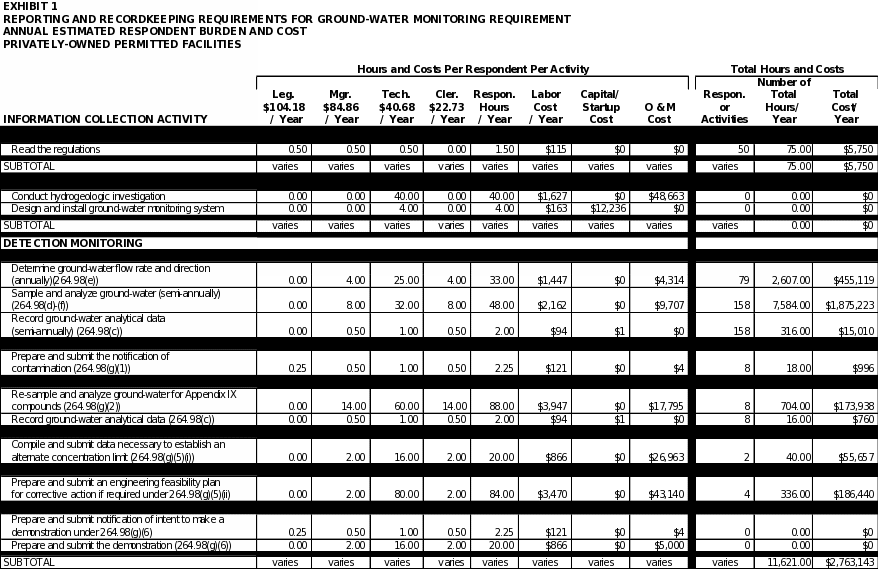
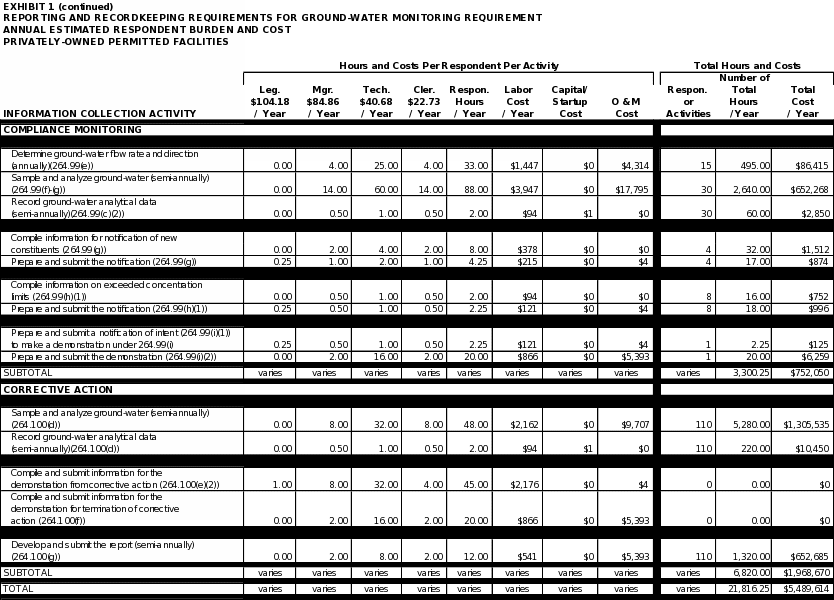
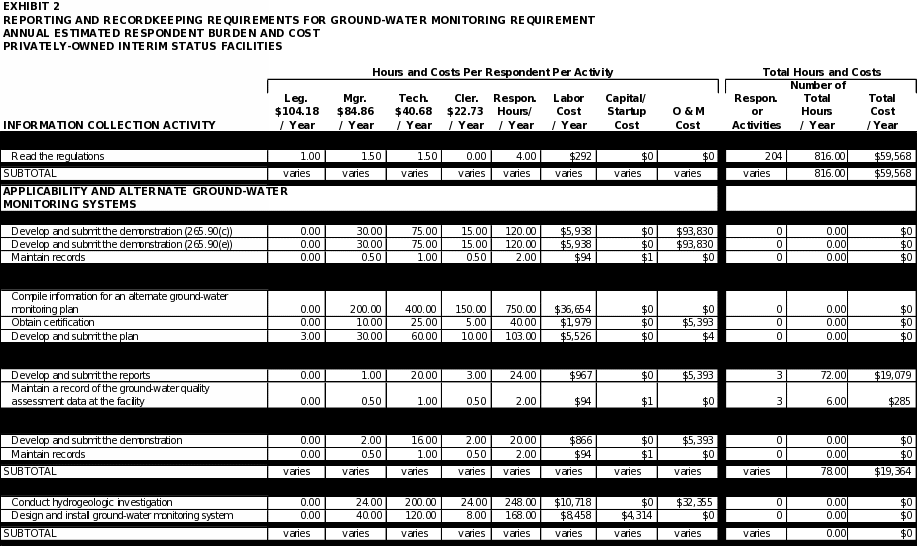
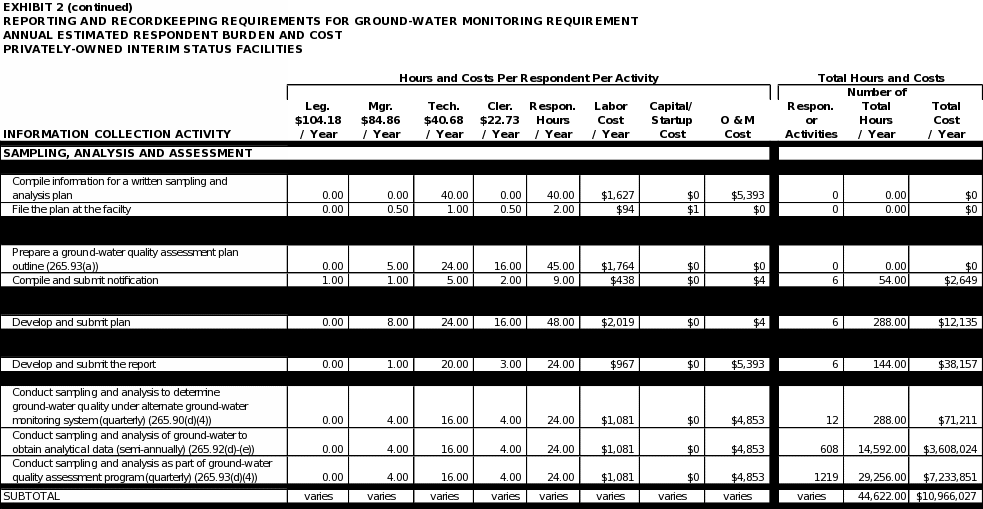

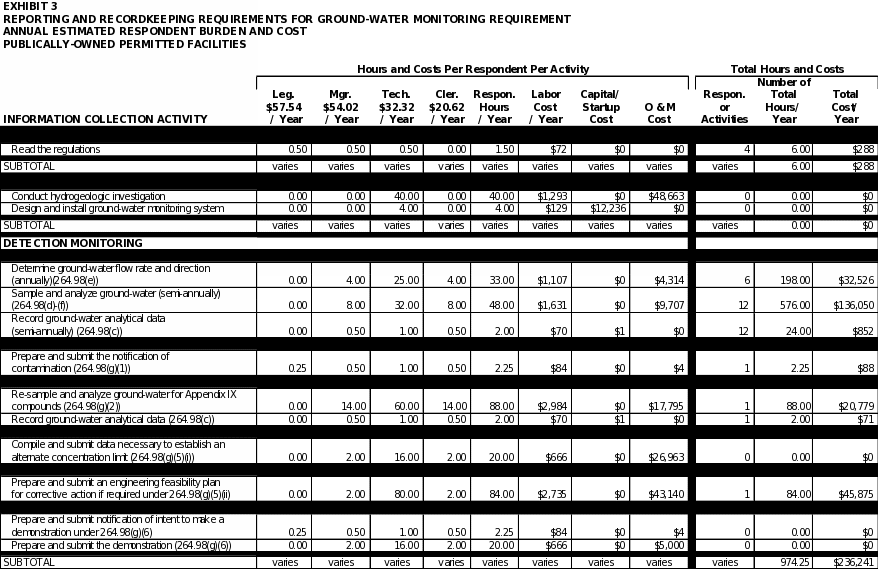
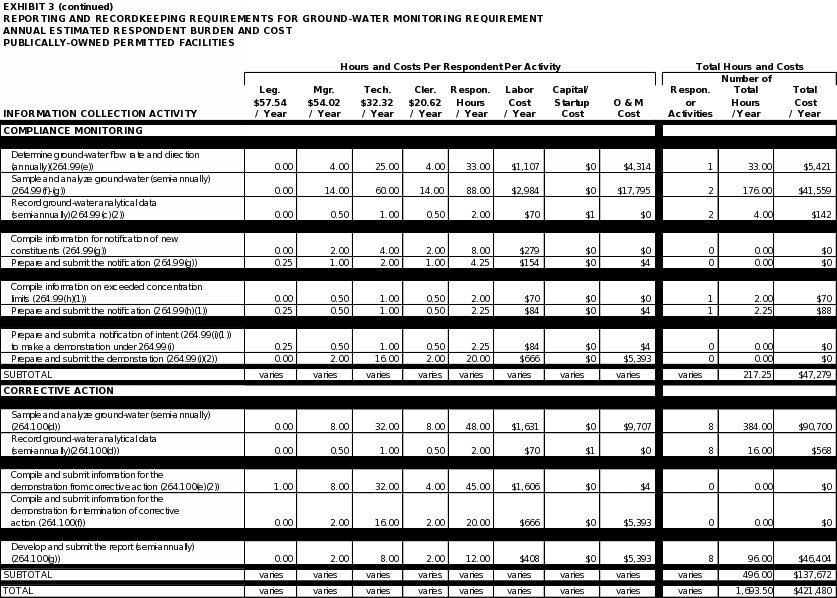

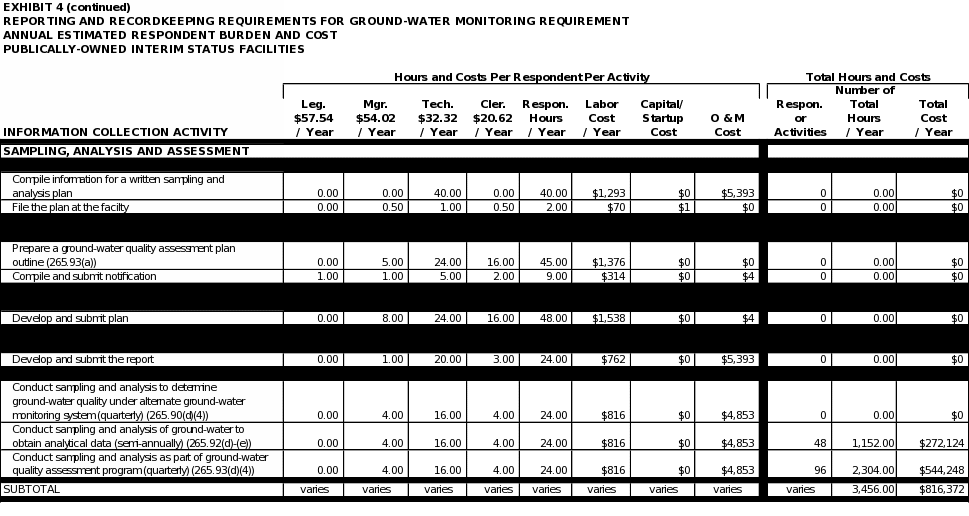
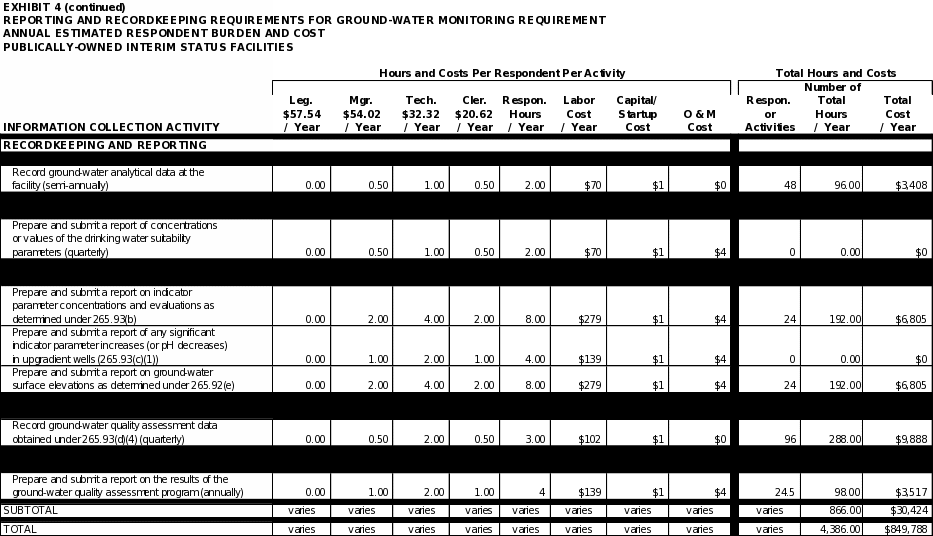
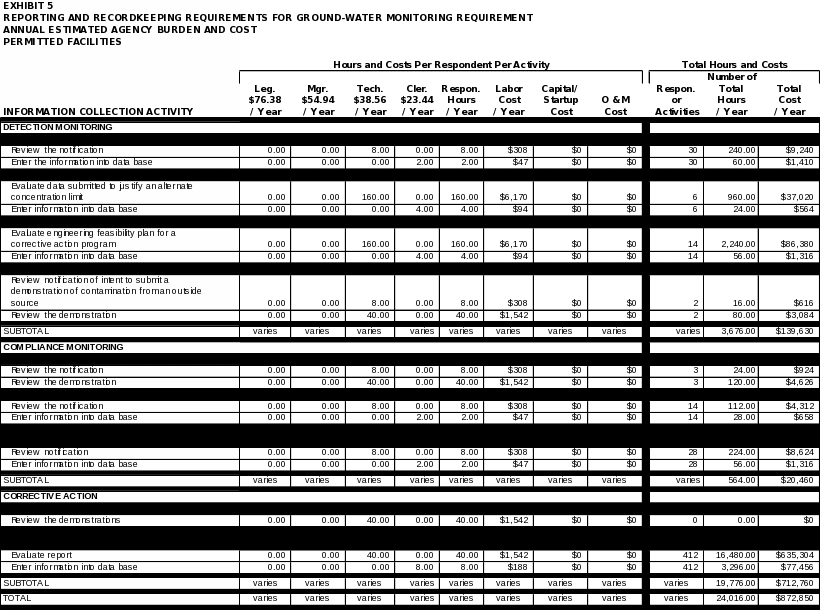
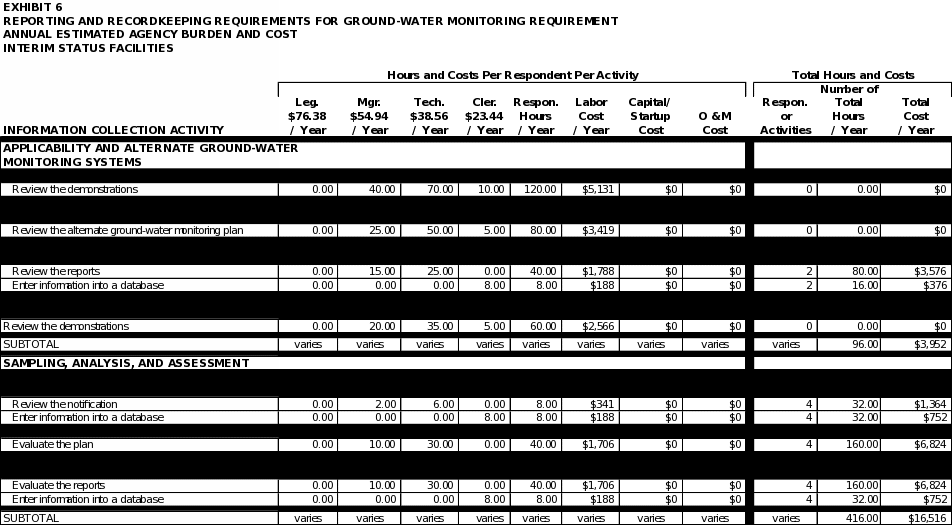
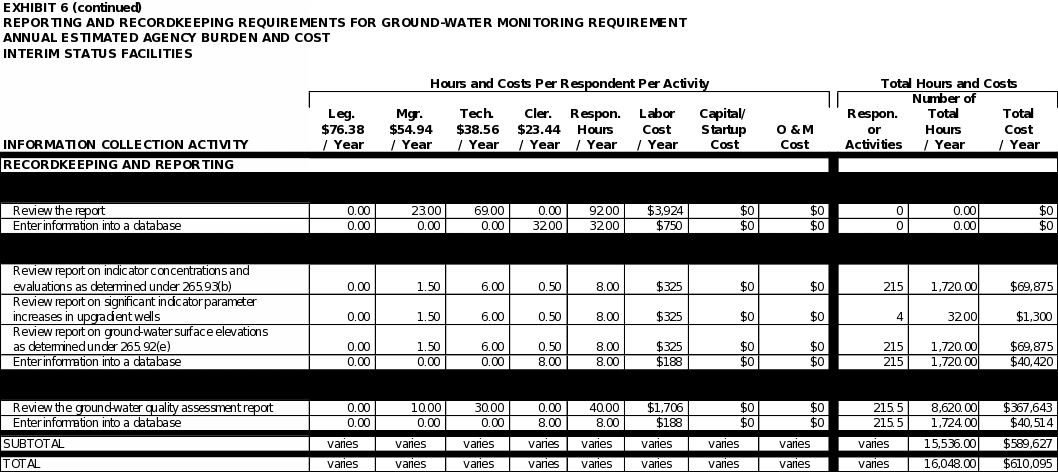

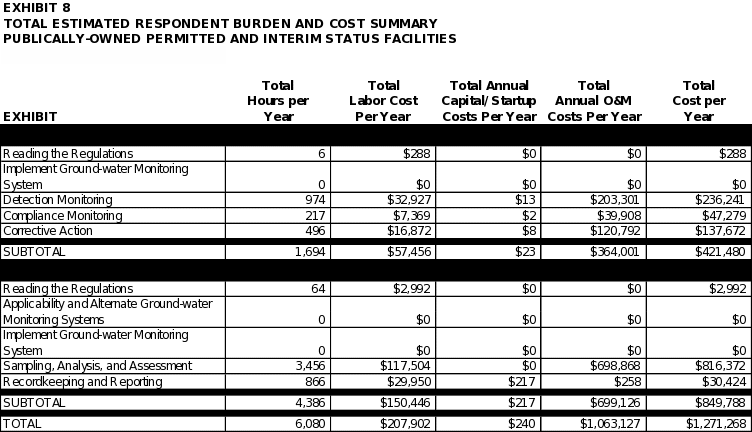
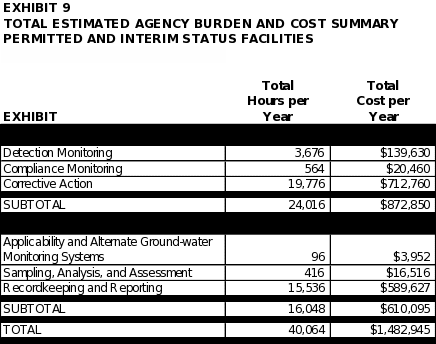
| File Type | application/msword |
| Author | MDSADM10 |
| Last Modified By | EPA |
| File Modified | 2012-01-19 |
| File Created | 2012-01-19 |
© 2025 OMB.report | Privacy Policy